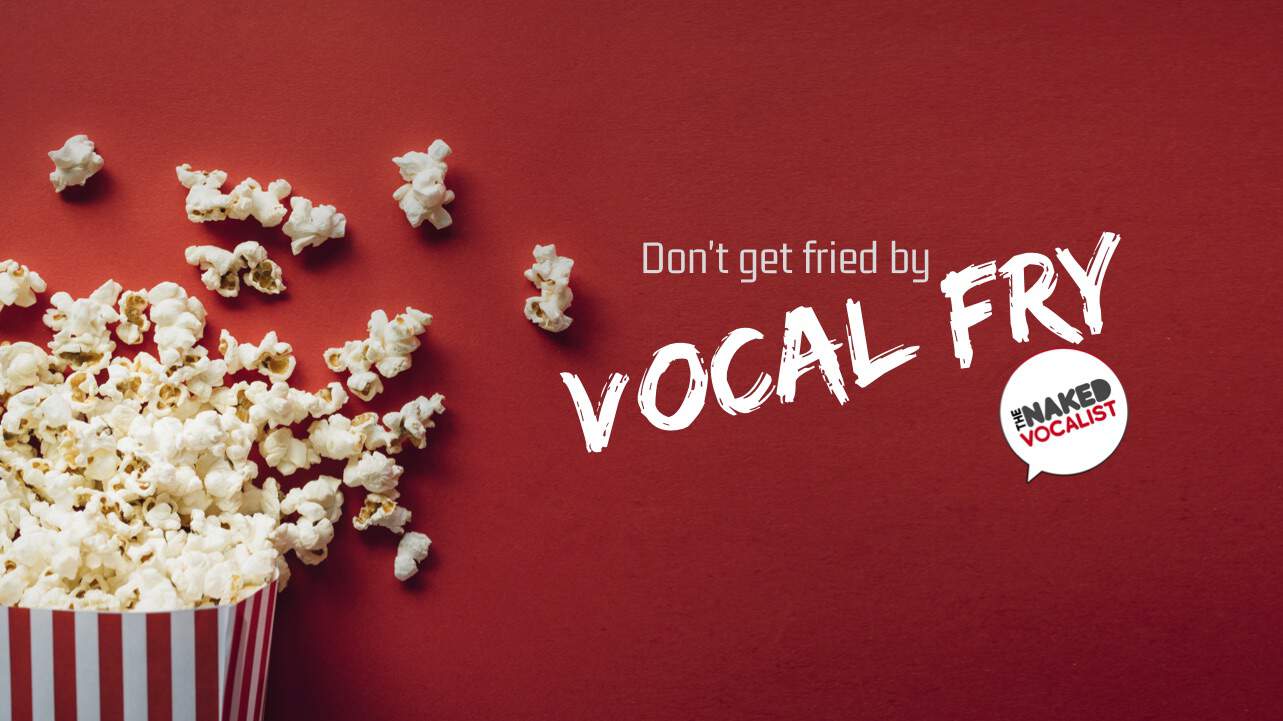
Vocal fry is a vocal register.
It’s even a technical tool.
It also makes you much cooler apparently, although some of us are beyond saving on that front.
Here’s the thing… vocal fry can also be the symptom of a vocal problem, a lack of needed energy and it could generally mess up the well-oiled machine that is your voice. This post is to show you what it is, which tools you can try and when to try them!
NOTE: Suitable for singers and coaches alike.
Let’s start with what it is…
Vocal fry, sometimes called pulse register, is a state where the vocal folds are very short, very lax and airflow is veeeeeerrrrrry slow through them. The vocal folds are also seen to be fully closed in fry video examinations.
When performing it, individual puffs of air making it slowly through the vocal folds, each one clearly audible. The result is a deep ‘croaking’, almost ‘popping’ sound.
One of the best names I found to describe a slow vocal fry is ‘popcorning‘. Love that.
Vocal fry isn’t even first gear and it can be found below the lowest definable notes in your voice. Below roughly 80Hz if you’re a massive nerd, although here’s a demo to avoid massive confusion:
Now do it!
Before we get into the rest of it, let’s start with the fun part.
Give it a go on an “AH” vowel. There aren’t really exercises specifically as pretty much everyone does it by imitation. Saying that, the feeling of space and looseness in the throat can be a big part of finding and keeping a stable fry. That’s why using a warmer tone and/or dialling back all effort might assist you.
If it’s genuinely hard to find, there could be another ‘thing’ that’s in the way like a stiff, dry or tense voice. Improve that situation and vocal fry is more likely to happen naturally.
If you found the legit vocal fry, then let’s run it out on some recommended exercises. A couple things though. First, try not to take really big breaths before any of these as tanking up makes this much harder and physically tiring! Secondly, these exercises are only appropriate for 2 minutes and must be followed by falsetto glides to balance them out.
The toolbox
Every singer and coach needs one of these, so here are your fry tools. With all these exercises, check the “Why you might need vocal fry” section afterwards to make sure you’re using these to help your current situation. Otherwise, you might end up throwing a spanner in the works!
The sustain
All you need to do is sustain your vocal fry for between 5-10 seconds. You can use an “AH” vowel or the consonant “M” with the tongue slightly out, which avoids common tongue tenseness problems. Repeat three times. That’s it!
NOTE: If fry doesn’t come easily on the “AH” or “M”, try a loose feeling “OH” vowel. That might help create the space and looseness needed to settle it down. Don’t worry if you can’t find it at all, but make a note to explore possible vocal tension with a kick ass coach.
The onset exercise
The fry is short lived in this exercise as it’s only needed to influence the sound and register that comes after it. A starting point here is to fry into the consonant M. Then open out to a clear vowel on a 3 or 5 note scale whilst preserving the ‘fry’ onset of the M. You could use words like MAH or MA. Even MOO. The vowel following the M should NOT be fried, a bit like this:
Stylistic fry
Save this one for when your engine is warm and you are ready to practice songs.
This time we’re frying into a phrase for stylistic purposes. This adds a bit of emotion, coolness, or interest to whatever it is you are singing. All that’s left here to experiment! Start with frying into phrases that begin with just a vowel, like “I” or “every”. Technically speaking, consonants “w” and “y” are spoken similarly to the vowels “oo” and “ee”, so you’ll find it works on them too. There are consonants where it really doesn’t work, but enough experimenting will tell you all this anyway. Record yourself and review to spot any odd moments! Here’s a bit of Daniel Ceasar to show you what I mean, but it might remind you of a few more artists who use this effect:
Between the clean version and the fry version, what kind of overall emotion does it help help to bring to the piece? Does it change up the style? Does it suit the context of the lyrics? The answers to questions like these will help you to use fry to serve the song and message, rather than randomly peppering it in.
IMPORTANT: The ‘Balancers’
Fry is an extreme voice quality. As recommended by US researcher and vocal coach John Nix, be sure to vary your practice around fry by gliding down from your head voice/falsetto regularly during training to avoid picking up fry-related problems.
Also very important, is that stylistic fry and fry exercises are NOT for the high ranges. Stick around the bottom, kay?
Educated singers = healthy, happy singers
I use these exercises often with the singers I work with because they are quite useful. BUT, vocal fry is so often taken too far or overused in songs. That can and does lead to vocal tension and reduced capability. Because I have a responsibility to make sure you are staying tip top, please read on and makes sure you’re up on what could accidentally grind those gears.
Why you might need vocal fry
Breathy, leaky and ‘lacking chest’ tone
This is a super-standard use for vocal fry because it tries to activate the muscles that close the vocal folds. When those folds come together, it will result in a much less breathy tone. Singers who have struggled with being heard, getting louder in dramatic songs or finding ‘chest voice’ can make great progress with a little peppering of fry training each day for the short term. Use the holds and the onset exercises for this.
On the other hand, singers who might already be quite rich in the low range or struggle a bit with getting to falsetto might want to tread carefully. Training vocal fold closure with fry could make things worse!
Involving less throat
When frying, the sensation of looseness in the throat muscle and lower breath energy can be a great tool for bringing a singers mind and body into a specific feeling. One where complete vocal fold closure comes easy under less effort. Coaches will know that many learning singers associate singing with high effort, so this can be very useful in quickly getting out of that association. Matching that level of effort contribution as you sing, just not with the sound of fry, is how you reap the rewards from this approach.
NOTE: Using fry for this reason is really for brain training; to momentarily feel something different so you can make changes to your singing consciously. Because of that, you only use fry for a second to change up the situation, rather than rep it out for muscle memory.
Reduce nasal tone
Brilliantly, because of our body’s biomechanical hardwiring, the soft palette raises when we aim for fry. This avoids too much of your sound getting stuck in the nose.
Try it on an AH vowel, which can be a very nasal vowel for singers who struggle with nasality. You’ll notice that space above the back of the tongue opens up more than usual during a short fry. Singing off the back of a short fry, but whilst keeping some of the spacial feeling in the palette area, could be the short cut to reduce nose in your tone!
Very low male voices
There’s been a few of the classical ‘legends’ over the last few hundred years who swear by a bit of fry for expanding the low notes in a deep baritones or basses voice. That resonance rumble is very desirable and sometimes needs a wake up. For me, I don’t usually use it for that because my clientele very rarely need it!
Cooling down
Cooling down is a fairly underrated and underused technique that needs more championing. Especially for high intensity singers and those who sing very pitches, including the high belters and classical sopranos. Essentially, it’s bring your voice back down to a relaxed speaking place and giving the singing muscles a chance to calm down. The benefit of this is that if certain singers don’t cool down, the tensions they pick up during performances carry over to the next day. Then you sing again, and again, and it eventually adds up to a chronic state where vocal performance is affected. Spending time cooling down after each performance, which can incorporate a little vocal fry as a way of slackening the vocal folds from their tensed singing state, is a must for the busy performer.
FOR THE COACHES… a diagnostic tool
There might not be anything sinister about vocal fry being missing, but I find it becomes part of how I assess singers. If you can’t weed it out, then a singers larynx may be unable to fully relax. Over a longer time that can lead to chronic tension and then injury, so it’s actually helpful to note if vocal fry isn’t easily found.
Vocal fry may also be difficult, maybe even impossible, when stiffness or vocal fold injuries are present. These injuries can stiffen the vocal fold mucosa, whereas fry relies on pliable vocal folds.
If fry isn’t coming, and there are a few other signs that are telling you the singers vocal folds might be having some difficulty, keep the option open for the singer to visit the voice clinic for a check up.
Unintentional vocal fry – beware!
I know I’ve already banged on about it, but please avoid using fry a lot. That includes in speech. It actually qualifies as an extreme position of the larynx joint: A position where the muscles of chest voice and vocal fold closure are highly dominant over the others. The impact of living in that imbalance is most probably reduced range and freedom, so if you speak in fry habitually then there’s a greater chance of singing being a big pain in the ass.
Studies have shown that fry can also make dysphonia and persistent hoarseness worse. Fry seems to pop up regularly when singers and speakers are running out of breath to fuel their voice, so you could be spotting a need to work on breathing if you hear it very often!
All that’s left to say is experiment with fry. It’s a great stylistic tool to polish up your sound. Used sparingly, it’s a great way of tightening those loose screws in your voice.
Just don’t be a spanner.
Here’s the reading list for the nerds:
The Voice Clinics Handbook – Tom Harris
Titze et al 2005 – Application of Vocal Fry to the Training of Singers
William Vennard – The Voice and The Mechanic
Cornelius Reid – VOCAL MECHANICS AND THE CULTIVATION OF LISTENING SKILLS
Manual Of Singing Voice Rehabilitation – Leda Scearce
Vocology: The Science and Practice of Voice Habilitation – Titze & Verdolini
Effect of Vocal Fry on Voice and on Velopharyngeal Sphincter – Elias et al






